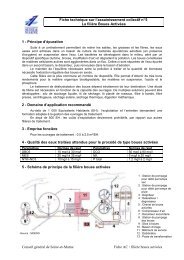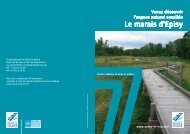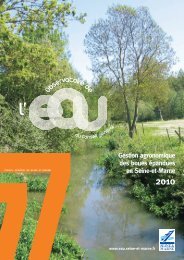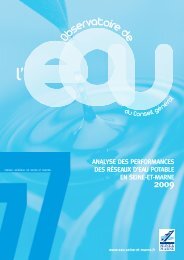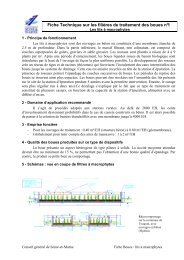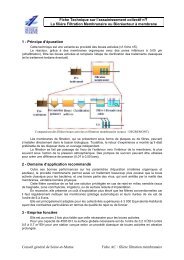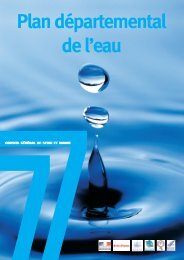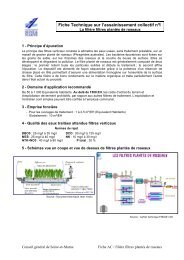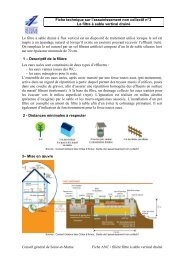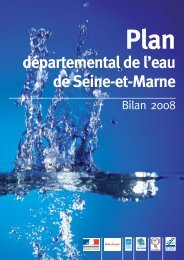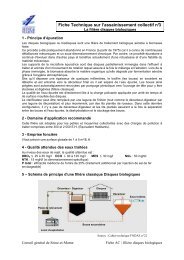Fiche Technique AC n°4 Filtre à sable - Site de l'eau en Seine-et ...
Fiche Technique AC n°4 Filtre à sable - Site de l'eau en Seine-et ...
Fiche Technique AC n°4 Filtre à sable - Site de l'eau en Seine-et ...
- No tags were found...
You also want an ePaper? Increase the reach of your titles
YUMPU automatically turns print PDFs into web optimized ePapers that Google loves.
<strong>Fiche</strong> <strong>Technique</strong> sur l’assainissem<strong>en</strong>t collectif n°4La filière filtre à <strong>sable</strong>1 - Principe d’épurationCe procédé épuratoire consiste à infiltrer les eaux usées prétraitées (traitem<strong>en</strong>t primaire) dans unmilieu granulaire (<strong>sable</strong>) sur lequel est fixée la biomasse épuratoire.Le prétraitem<strong>en</strong>t a pour fonction <strong>de</strong> r<strong>et</strong><strong>en</strong>ir les graisses <strong>et</strong> d'assurer la décantation <strong>de</strong>s matières <strong>en</strong>susp<strong>en</strong>sion cont<strong>en</strong>ues dans l'efflu<strong>en</strong>t. Trois dispositifs (fosse toutes eaux, Décanteur-digesteur oulagune <strong>de</strong> décantation) peuv<strong>en</strong>t être mis <strong>en</strong> place <strong>en</strong> amont <strong>de</strong>s filtres, chacun avec <strong>de</strong>s domainesd'utilisation spécifiques.La filtration sur <strong>sable</strong> perm<strong>et</strong> principalem<strong>en</strong>t d'oxy<strong>de</strong>r la matière organique, <strong>de</strong> nitrifier l'azoteammoniacal (formation <strong>de</strong> nitrates) mais aussi <strong>de</strong> réduire les germes pathogènes. L'aération estassurée par une diffusion <strong>de</strong> l'oxygène <strong>de</strong>puis la surface <strong>de</strong>s filtres <strong>et</strong> les cheminées d'aération versles espaces poreux.Le système d'alim<strong>en</strong>tation est conçu <strong>de</strong> manière à obt<strong>en</strong>ir une distribution uniforme <strong>de</strong>s efflu<strong>en</strong>ts àinfiltrer sur la totalité <strong>de</strong> la surface disponible. Généralem<strong>en</strong>t, la répartition est assurée à partir d'unréservoir <strong>de</strong> chasse ou d'une pompe <strong>de</strong> relèvem<strong>en</strong>t.Habituellem<strong>en</strong>t, le dispositif est composé <strong>de</strong> trois massifs filtrants, un <strong>en</strong> service, les <strong>de</strong>ux autres aurepos, avec alternance hebdomadaire. Pour éviter tout colmatage interne du massif, il est <strong>en</strong> eff<strong>et</strong>nécessaire <strong>de</strong> réguler le développem<strong>en</strong>t <strong>de</strong>s microorganismes épurateurs par alternance <strong>de</strong>l'alim<strong>en</strong>tation <strong>de</strong>s ouvrages, perm<strong>et</strong>tant ainsi la régénération du filtre. Cela est obt<strong>en</strong>u par <strong>de</strong>s phases<strong>de</strong> repos p<strong>en</strong>dant lesquelles les microorganismes car<strong>en</strong>cés sont réduits par prédation <strong>et</strong> par<strong>de</strong>ssiccation.Le colmatage est la cause principale <strong>de</strong>s défaillances <strong>de</strong>s systèmes d'infiltration-percolation. Uneconception (<strong>sable</strong> siliceux avec une granulométrie spécifique) <strong>et</strong> une exploitation rigoureuses sontdonc nécessaires au bon fonctionnem<strong>en</strong>t d'un filtre à <strong>sable</strong>.2 - Domaine d’application recommandéC<strong>et</strong>te filière est adaptée pour les p<strong>et</strong>ites collectivités avec <strong>de</strong>s charges <strong>de</strong> pollution à traiter inférieuresà 400 E.H. (Equival<strong>en</strong>t Habitants).3 - Emprise foncièreLa surface <strong>de</strong> filtre par E.H. est <strong>de</strong> 1,5 m² pour un filtre à surface libre <strong>et</strong> <strong>de</strong> 3 m² pour un filtre <strong>en</strong>terré.La surface globale varie <strong>de</strong> 5 à 10 m²/E.H.4 - Qualité att<strong>en</strong>due <strong>de</strong>s eaux traitéesAu niveau <strong>de</strong>s eaux <strong>de</strong> rej<strong>et</strong>, la qualité att<strong>en</strong>due est :DBO5 ≤ 25 mg/l DCO ≤ 90 mg/l MES ≤ 30 mg/l NTK : 10 à 20 mgN/lNGL : 30 à 60 mgN/l P total : globalem<strong>en</strong>t faible, variable suivant l'âge du dispositif (filière nonadaptée au traitem<strong>en</strong>t <strong>de</strong> ce paramètre)5 - Avantages <strong>et</strong> inconvéni<strong>en</strong>ts <strong>de</strong> la filièreAvantages- Excell<strong>en</strong>tes performances sur laDBO 5 , la DCO <strong>et</strong> les MES- Nitrification poussée- Décontamination bactériologiqueintéressante- Gestion <strong>de</strong>s boues facilitéeInconvéni<strong>en</strong>ts- Peu adapté aux surcharges hydrauliques <strong>et</strong> organiquesmême passagères- Nécessité d'un ouvrage <strong>de</strong> décantation primaire efficace- Risque élevé <strong>de</strong> colmatage- S<strong>en</strong>sibilité au gel assez importante- Prés<strong>en</strong>ce <strong>de</strong> nitrates <strong>en</strong> quantité importante au rej<strong>et</strong>- Nécessité d'un <strong>en</strong>tr<strong>et</strong>i<strong>en</strong> régulierConseil général <strong>de</strong> <strong>Seine</strong>-<strong>et</strong>-Marne<strong>Fiche</strong> <strong>AC</strong> / filière filtre à <strong>sable</strong>
6 – Schéma <strong>de</strong> principe d'un filtre à <strong>sable</strong>Eaux uséesPoste stockage <strong>et</strong>injection (siphon)<strong>Filtre</strong> à <strong>sable</strong>Vue<strong>en</strong> coupeEauxtraitéesDécanteur - DigesteurAbri7 - Ouvrages <strong>en</strong> <strong>Seine</strong> <strong>et</strong> MarneVuedu <strong>de</strong>ssusSource : Cahier technique FNDAE n°22Quincy Voisins – <strong>Filtre</strong> <strong>en</strong>terréHameau <strong>de</strong> Moulignon (150 E.H.)Forges – Les hameaux (110 E.H.)<strong>Filtre</strong> à surface libre Constructeurs <strong>en</strong> seine <strong>et</strong> Marne :Voisins, Merlin TP, SADE, EPARCO, … Quelques référ<strong>en</strong>ces : Dhuisy (500 E.H.), Reuil <strong>en</strong> Brie – Till<strong>et</strong> (180 E.H.), Forges – Les hameaux (110 E.H.),Recloses (800 E.H.), Ussy sur Marne – Moli<strong>en</strong> (50 E.H.), Saints – Maison Meunier (120 E.H.), Montmachoux(250 E.H.), Choisy <strong>en</strong> Brie – Champbonnois (133 E.H.)…8 - Pour aller plus loin• Docum<strong>en</strong>t technique du Ministère <strong>de</strong> l’Agriculture <strong>et</strong> <strong>de</strong> la pêche (FNDAE n°22) : Filières d’épurationadaptées aux p<strong>et</strong>ites collectivités : http://www.fndae.fr/docum<strong>en</strong>tation/numero_22.htm• Gui<strong>de</strong> <strong>de</strong>s procédés ext<strong>en</strong>sifs d'épuration <strong>de</strong>s eaux usées adaptés aux p<strong>et</strong>ites <strong>et</strong> moy<strong>en</strong>nescollectivités – Commission Europé<strong>en</strong>ne, Ministère <strong>de</strong> l'Aménagem<strong>en</strong>t du Territoire <strong>et</strong> <strong>de</strong>l'Environnem<strong>en</strong>t, Ag<strong>en</strong>ces <strong>de</strong> l'Eau :http://www.ecologie.gouv.fr/IMG/pdf/gui<strong>de</strong>-traitem<strong>en</strong>t-eaux-usees-2002.pdfConseil général <strong>de</strong> <strong>Seine</strong>-<strong>et</strong>-Marne<strong>Fiche</strong> <strong>AC</strong> / filière filtre à <strong>sable</strong>



